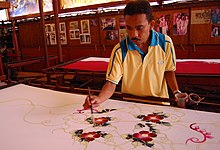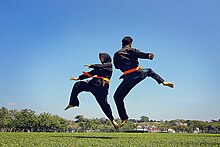Culture

Traditional Malaysian art was mainly centred on the areas of carving, weaving, and silversmithing.[249] Traditional art ranges from handwoven baskets from rural areas to the silverwork of the Malay courts. Common artworks included ornamental kris, beetle nut sets, and woven batik and songket fabrics. Indigenous East Malaysians are known for their wooden masks.[131] Each ethnic group have distinct performing arts, with little overlap between them. However, Malay art does show some North Indian influence due to the historical influence of India.[250] Traditional Malay music and performing arts appear to have originated in the Kelantan-Pattani region with influences from India, China, Thailand and Indonesia. The music is based around percussion instruments,[250] the most important of which is the gendang (drum).
History

vidence of modern human habitation in Malaysia dates back 40,000 years.In the Malay Peninsula, the first inhabitants are thought to be Negritos.[39] Traders and settlers from India and China arrived as early as the first century AD, establishing trading ports and coastal towns in the second and third centuries. Their presence resulted in strong Indian and Chinese influences on the local cultures, and the people of the Malay Peninsula adopted the religions of Hinduism and Buddhism. Sanskrit inscriptions appear as early as the fourth or fifth century.[40] The Kingdom of Langkasuka arose around the second century in the northern area of the Malay Peninsula, lasting until about the 15th century.[34] Between the 7th and 13th centuries, much of the southern Malay Peninsula was part of the maritime Srivijayan empire. By the 13th and the 14th century, the Majapahit empire had successfully wrested control over most of the peninsula and the Malay Archipelago from Srivijaya. Islam began to spread among Malays in the 14th century.[42] In the early 15th century, Parameswara, a runaway king of the former Kingdom of Singapura linked to the old Srivijayan court, founded the Malacca Sultanate. Melaka was an important commercial centre during this time, attracting trade from around the region.
Geography

Malaysia is the 66th largest country by total land area, with a land area of 329,613 km2 (127,264 sq mi). It has land borders with Thailand in West Malaysia, and Indonesia and Brunei in East Malaysia.[2] It is linked to Singapore by a narrow causeway and a bridge. The country also has maritime boundaries with Vietnam[128] and the Philippines.[129] The land borders are defined in large part by geological features such as the Perlis River, the Golok River and the Pagalayan Canal, whilst some of the maritime boundaries are the subject of ongoing contention.[2] Brunei forms what is almost an enclave in Malaysia,[130] with the state of Sarawak dividing it into two parts. Malaysia is the only country with territory on both the Asian mainland and the Malay archipelago.[131] Tanjung Piai, located in the southern state of Johor, is the southernmost tip of continental Asia.[132] The Strait of Malacca, lying between Sumatraand Peninsular Malaysia, is one of the most important thoroughfares in global commerce, carrying 40 per cent of the world's trade.[133]The two parts of Malaysia, separated from each other by the South China Sea, share a largely similar landscape in that both Peninsular and East Malaysia feature coastal plains rising to hills and mountains.[2] Peninsular Malaysia, containing 40 per cent of Malaysia's land area,[131] extends 740 km (460 mi) from north to south, and its maximum width is 322 km (200 mi).[134] It is divided between its east and west coasts by the Titiwangsa Mountains,[135] rising to a peak elevation of 2,183 metres
Sports

Popular sports in Malaysia include association football, badminton, field hockey, bowls, tennis, squash, martial arts, horse riding, sailing, and skate boarding.[194] Football is the most popular sport in Malaysia and the country is currently studying the possibility of bidding as a joint host for 2034 FIFA World Cup. adminton matches attract thousands of spectators, and since 1948 Malaysia has been one of four countries to hold the Thomas Cup, the world team championship trophy of men's badminton.[276] The Malaysian Lawn Bowls Federation was registered in 1997. Squash was brought to the country by members of the British army, with the first competition being held in 1939. The Squash Racquets Association Of Malaysia was created on 25 June 1972.[279] Malaysia has proposed a Southeast Asian football league.[280] The men's national field hockey team ranked 13th in the world as of December 2015. The 3rd Hockey World Cup was hosted at Merdeka Stadium in Kuala Lumpur, as well as the 10th cup. The country also has its own Formula One track–the Sepang International Circuit. It runs for 310.408 kilometres (192.88 mi), and held its first Grand Prix in 1999.[283] Traditional sports include Silat Melayu, the most common style of martial arts practised by ethnic Malays in Malaysia, Brunei, and Singapore.
Road

There is currently 1,833 kilometres (1,139 mi) of railways in Malaysia, 767 km (477 mi) are double tracked and electrified. Rail transport in Malaysia comprises heavy rail (KTM), light rapid transit and monorail (Rapid Rail), and a funicular railway line (Penang Hill Railway). Heavy rail is mostly used for intercity passenger and freight transport as well as some urban public transport, while LRTs are used for intra-city urban public transport. There two commuter rail services linking Kuala Lumpur with the Kuala Lumpur International Airport. The sole monorail line in the country is also used for public transport in Kuala Lumpur, while the only funicular railway line is in Penang. A rapid transit project, the KVMRT, is currently under construction to improve Kuala Lumpur's public transport system. The railway network covers most of the 11 states in Peninsular Malaysia. In East Malaysia, only the state of Sabah has railways. The network is also connected to the Thai railway 1,000 mm (3 ft 3 3/8 in) network in the north. If the Burma Railway is rebuilt, services to Myanmar, India, and China could be initiated. Malaysia has 118 airports, of which 38 are paved. The national airline is Malaysia Airlines, providing international and domestic air services. Major international routes and domestic routes crossing between West Malaysia and East Malaysia are served by Malaysia Airlines, AirAsia and Malindo Air while smaller domestic routes are supplemented by smaller airlines like MASwings, Firefly and Berjaya Air. Major cargo airlines include MASkargo and Transmile Air Services. Kuala Lumpur International Airport is the main and busiest airport of Malaysia. In 2014, it was the world's 13th busiest airport by international passenger traffic, recording over 25.4 million international passenger traffic. It was also the world's 20th busiest airport by passenger traffic, recording over 48.9 million passengers. Other major airports include Kota Kinabalu International Airport, which is also Malaysia's second busiest airport and busiest airport in East Malaysia with over 6.9 million passengers in 2013, and Penang International Airport, which serves Malaysia's second largest urban area, with over 5.4 million passengers in 2013.